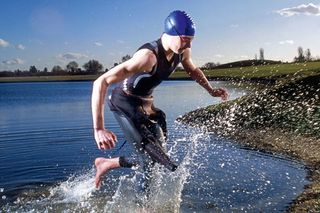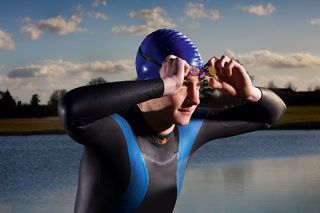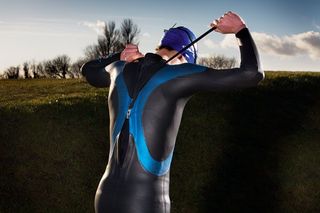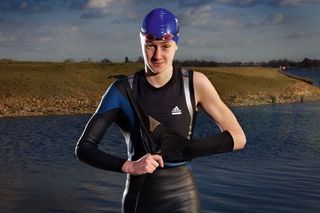Improve Your Triathlon Swimming
Junior World Triathlon Champion Alistair Brownlee tells you how to power through the first stage of a triathlon

This article was first published in 2008 then updated in 2022 to improve the formatting.
For many athletes, the swimming leg is the biggest challenge in a triathlon. 2006 Junior World Triathlon Champion Alistair Brownlee shares training tips to improve your triathlon swimming and facilitate a speedy transition out of the water.
We've also got advice from pros on how to improve your triathlon cycling and improve your triathlon running.
If you're training for a triathlon, check out our pick of the UK's best triathlons and follow one of our triathlon training plans.
Train indoors and outdoors
"Ok, so during the winter you’ll have to train in a pool," says Brownlee. "But when it gets warmer you should practise in open water so you’ll know what to expect during a race. You want to do one speed session and one distance session per week."
Get some coaching
"It’s a good idea, no matter what your level," says Brownlee. "Even if you’re doing loads of training on your own, there could be crucial technical aspects you’re getting wrong."
Warm-up properly before the event
"I do two or three sprints of around 20 strokes and go for a short jog just before a race," says Brownlee. "Keep moving around right up until the race starts so your muscles are warmed up."
Get the Coach Newsletter
Sign up for workout ideas, training advice, reviews of the latest gear and more.
Make sure you have enough in the tank
"I have a good breakfast on the day of the race – something that’s packed with slow-release energy, such as cereal or porridge," says Brownlee. "I’ll have an energy bar just before the race which delivers a quick-hit of fuel."
Be prepared for some argy bargy
"The first 200 metres of the swim are really frantic," says Brownlee. "People will try to get past you by grabbing your shoulders, pulling your suit down or elbowing you in the face. If you’re new to triathlons and are more concerned about finishing than winning a race, I’d recommend starting on the outside of the pack. That way you’ll avoid the worst of it."
Slipstream to save energy
"You’ll want to save energy for the next two stages, so ideally you want to find someone who’s slightly faster than you and get into their slipstream," says Brownlee. "If you swim on their feet, they’re breaking up the water so there’s less resistance to slow you down or tire you out. It’s also important to scope out the route so you know where you’re going – you want to take the fastest, straightest line between the buoys."
Break up your breathing
"Normally people breathe once every two to five strokes," says Brownlee. "If you take a breath every stroke it will stop you building up the kind of speed that two or three strokes in a row generate. If you’re in a scrum someone could stop you lifting your head out of the water when you plan to, so you have to be able to break your breathing pattern. You should practice breathing at random intervals during training – look up every ninth or tenth stroke to get your bearings. Just make sure it’s a continuous part of your stroke or it will slow you down."
Use your arms more than your legs
"Your arms should be doing most of the work so you’ve got power in your legs for the next stages," says Brownlee. "You need to reach ahead with your leading hand while raising your other elbow so you’re pulling water back with a sculling motion. The most powerful bit of the stroke should be from when your arm passes under your shoulder until it comes out by your hip. Pull it out of the water in a relaxed manner so it can recover a bit for the next stroke. Kick from your hips and keep your leg straight so the whole limb is generating power."
Get the right wetsuit
"You need one that’s buoyant and gives a lot of freedom of movement around the shoulder area," says Brownlee.
Alistair Brownlee
Age: 20
From: Horsforth, Leeds
Achievements: 2006 Winner, Junior World Triathlon Championships. 2006 Winner, National Junior Triathlon Championships. 2007 2nd, Junior World Triathlon Championships.
Transition like Alistair Brownlee
Getting out of your wetsuit efficiently is the key to a fast swim/bike transition – here are Alistair Brownlee's top tips for getting out of the water and onto the bike.
Goggles off first

"Leave them on your swimming cap," says Brownlee. "If you’re holding them in your hands it will make it harder to get your suit off. You should aim to replace your goggles every three or four races because they will fog up. You can use anti-fog agents, but they're not that effective."
Unzip your suit

"Rip apart the Velcro at the top of the suit, then undo the zip by pulling the leash up," says Brownlee. "You want a wetsuit with a zip that opens upwards because it’s easier to release and harder for people to pull down during the swim."
Pull it down

"Yank the wetsuit over each elbow – if you try to tug it down your upper arms in stages you’ll lose time," says Brownlee. "Remove the legs by rolling one down and standing on it before you pull down the next one. Some people cut up their wetsuits in order to get them off faster, but putting baby oil or KY jelly on your arms and legs is just as good."
More About Triathlons
- Master all three elements with this how to train for a triathlon guide and get triathlon training right
- Looking to buy triathlon gear but not sure what to get? Our beginner's guide has the kit you need to master a multi-sport event
- Boost your triathlon endurance and go harder for longer on your bike, in the pool and around the track with these useful tips
- Writer Ben Ince learns total immersion swimming for triathletes and transforms his swimming stamina
Nick Hutchings worked for Men’s Fitness UK, which predated, and then shared a website with, Coach. Nick worked as digital editor from 2008 to 2011, head of content until 2014, and finally editor-in-chief until 2015.
